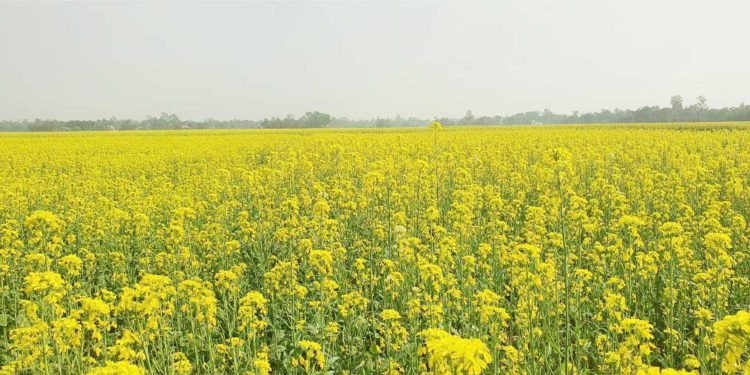Akkelpur, Joypurhat – The crop fields of Akkelpur upazila of Joypuhat are covered in yellow mustard flowers. It looks like a yellow princess is wearing yellow. Butterflies, bees, insects and other birds have come to these fields. Such an eye-catching nature can be seen in different areas of the upazila.
As far as the eye can see, the yellow mustard flowers can be seen. This vast field looks like a huge yellow sheet from a distance. Even in the dust and fog, the yellow mustard can be seen from a distance. There is a collection of turmeric all around the vast field. Even in the winter of Magh, nature seems to have a touch of spring. Young men and women are busy taking pictures and selfies to feel the touch of spring.
Mustard has been cultivated in every village of the upazila’s 5 unions and 1 municipality. However, local farmers have cultivated the most mustard in Akkelpur municipality, Tilakpur, and Raykali unions of the upazila.
If the weather is favorable, the farmers are hoping that mustard will be more profitable than rice. They will start preparing land for rice cultivation after raising mustard indoors. Now the farmers in these areas are spending a lot of time taking care of mustard. Farmers’ worries will be dispelled only if they can collect ripe mustard from the land. The target for the entire upazila in the current season was 2,410 hectares of land. But due to the high demand for potatoes in the market, farmers have shifted to cultivating potatoes instead of mustard. According to office sources, this will result in less than three percent of the target for mustard.
Although different varieties of mustard are cultivated according to the farmer’s choice, about 90 percent of the mustard varieties are Bari 9, 14, 17, 18, and Bina 9.
Rashedul Islam Pilot, a farmer from Temaria village in Gopinathpur union of Akkelpur upazila, said, “Last season, I cultivated mustard on 4 bighas of land. I earned about 9.5 thousand taka per bigha of land. From preparing the land to harvesting the crop, I spent about 12 thousand taka on mustard cultivation on each bigha of land. If the weather is favorable, I expect to get about 24 maunds of mustard from these lands.”
Several farmers said that mustard cultivation does not require much labor like other crops. Along with the men, the women members of the family also work regularly to collect the ripe mustard from the land, thresh it, and then harvest the crop. Mustard cultivation increases the fertility of the land and also improves the yield of rice.
Farmer Md. Tariqul Islam of Shialapara village of Tilakpur union said, potato cultivation is risky. On the other hand, the price of edible oil is also high. Mustard can be harvested at home with little cost and in a short time. Since there was no storm, the yield of mustard has also been good this season. Last year, I cultivated mustard on 4 bighas of land. This time, I am sowing mustard on 5.5 bighas of land. At least 6 to 7 maunds of mustard are produced per bigha of land. After ploughing the land, seeds are sown, fertilizer and irrigation are applied. The average cost of threshing per bigha of land is 9 to 10 thousand taka. And mustard will be sold for 3,500 to 4,000 taka per maund. It is possible to earn at least 18 to 19 thousand taka by cultivating mustard on each bigha of land.
Abdus Salam, a farmer from Narikeli village in Raykali union of the upazila, said, “After cultivating mustard, the yield of rice also improves. The profit that was made in mustard cultivation last year could not have been achieved by cultivating rice earlier. So this time, I planted early-maturing rice. I am sowing mustard on 7 bighas of land after harvesting rice and the yield has been very good. If we can dry it in the sun and store it for later sale, the market price of mustard will be even higher,” he commented.
Upazila Agriculture Officer and Agriculturist Emran Hossain said, mustard is a promising crop in Akkelpur upazila. This year, as farmers are more interested in potato cultivation and it rained twice in a row in November, mustard cultivation has been less than last year. However, due to the favorable weather, a bumper yield of mustard is expected and farmers will also benefit more. So far, mustard has been cultivated on 1,625 hectares of land in the upazila.




















